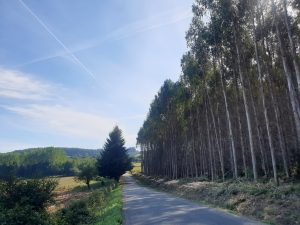
“Not all who wonder, or wander are lost.” ~ JRR Tolkien
For over a thousand years, many have walked the Camino Santiago (including one I draw immense inspiration from – Francis of Assisi – who walked the Camino from Italy to Santiago, Spain in 1214). Walking the Camino as a pilgrim (or peregrino as those on the Camino Santiago are called), has been a dream for quite some time. Through the generosity of two friends whom I accompanied and curated a walking desert odyssey, the opportunity presented itself in September 2022.

The inevitable question many who know about the Camino Santiago ask is why I was personally making this pilgrimage. Apart from being companions to two wonderful friends, I didn’t have any expectations prior to, nor any revelatory discoveries following the Camino, at least not to my conscious mind. Even as I write this, there is a deep unexplained stirring in my soul, and perhaps that is as it should be – that my finite mind has not yet, and might never, fully comprehend the breadth and depth of what I experienced. Here is my feeble attempt to mine some of the depth of what was experienced:
Walking in cadence with your heartbeat
I resonate deeply with Tolkien’s words that all who wonder, and wander are not lost. I’ll unpack this further in subsequent blogs.
An excerpt from ‘Bring on the Wonder’, a song by Susan Enan: 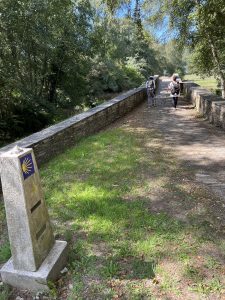
I don’t have the time for a drink from the cup
Let’s rest for a while till our souls catches up
Bring on the wonder
Bring on the song
I pushed you down deep in my soul for too long
Bring on the wonder
We got it all wrong
We pushed you down deep in our souls, so hang on
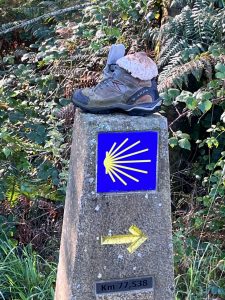 That is the refrain of the busy – we don’t have the time. Walking the Camino is a gift of time serving us, and not the tragic imprisonment of our souls in our serving time. A curious phrase we attribute to those who are incarcerated, yet tragically, could well be spoken of many of us who are physically free, yet not.
That is the refrain of the busy – we don’t have the time. Walking the Camino is a gift of time serving us, and not the tragic imprisonment of our souls in our serving time. A curious phrase we attribute to those who are incarcerated, yet tragically, could well be spoken of many of us who are physically free, yet not.
Given the time I had in taking about 200,000 steps on the Camino over 7 days, I did some mental calculations. With an elevated heart rate while walking of perhaps 100 beats a minute and the distance covered, taking into consideration the length of each stride, effectively, every step taken is in cadence with each heartbeat. Walking is about the only human activity that is in sync with life. When we walk, we walk at the speed of life (our heartbeat).
Even as we speak of the various issues of sustainability – environmental, climatic, natural resources – I wonder if Mahatma Gandhi’s maxim, “There is more to life than increasing its speed.” might be wisely heeded as we walk at the speed of life, for true sustainability.
When you take 200,000 steps, you also notice an obvious but overlooked phenomenon – when one foot is activated to take a step forward, the other foot lags to rest. Doing and being must be in balance.
Inhabiting a space larger than your ego can fill
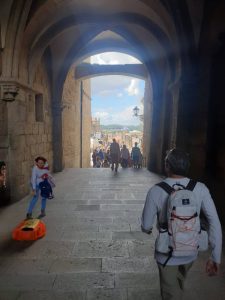
A question that has been posed to me since August 2014 is why I wasn’t ‘going back’ (curious yet a pointedly accurate and ironic phrase), to some semblance of my life prior to August 2014. I discovered the answer in part on the Camino. ‘Going back’, was precisely that. ‘Going back’ was to return to that which gave me a sense of identity, the personas/masks for which my face has grown to fit, and not the other way around, i.e., the persona/mask that fit my face, my core identity.
This next dispensation of my life is about a measure of hiddenness, brought into poignant reality on the Camino. Nobody knew me. We were all peregrinos, no matter how lofty the positions we hold or not.
A beautiful parable: a junior monk sees an older monk walking and asks, “What are you on pilgrimage for?” the junior monk asks. “I don’t know,” the elder answers, adding, “Non-knowing is most intimate.” Some of the most intimate experiences in life come when you can observe your journey without the expectation of some payoff. Outcomes are important but not always. To inhabit a space larger than one’s ego can fill, at times with more questions than answers, is daunting yet wonderfully enlivening.
Higher speeds diminish our peripheral vision
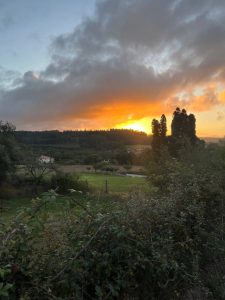
Getting to our destination as quickly as we can is the default objective. So, we jump into our car, ride the train, hop on an airplane. Totally understandable but tragically limiting. We miss the journey and the people and things that truly sustain us. We miss life even as we’re living it.
When we drive, or even when we run, our field of vision narrows to about 90 degrees as we need to focus on the road ahead. On the Camino, walking at the speed of life, every step in cadence with the heartbeat, widens the field of vision to 270 degrees. Walking allows the canvas of our lives to be fully utilised so as to paint the vast beauty of our very lives; missed in the speed that diminishes our peripheral vision, obscuring the parts of our canvas sadly left unexplored, unpainted. We observe less, we take in less, we discover less, and consequently, we feel less, are less.
I wonder – if we decreased our speed, might we see more intentionally, listen more deliberately, speak more circumspectly? Might we slow down long enough to understand another’s points of view rather than just rush headlong into the future clinging obstinately to ours?
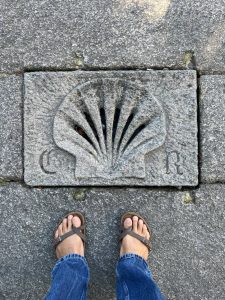
It would be a joy for me to accompany you on the Camino Santiago when you sense the time is right for you (look out for details on desertodyssey.com). In the meantime, I leave you with the beautiful exchange of greeting of peregrinos, “Buen Camino!” as you journey on the Camino of Life.
Actio Sequitur Esse (Action Follows Essence):
1. What does ‘walking at the speed of life’ mean for you? How will you find ways to balance being with doing?
2. How might we divest ourselves, even momentarily, from the insatiable expectations from activities we engage in, and more so, people we interact with?
3. What parts of my life’s canvas am I missing because of my focused intent to move forward faster?

4 thoughts on “Walking at the Speed of Life”